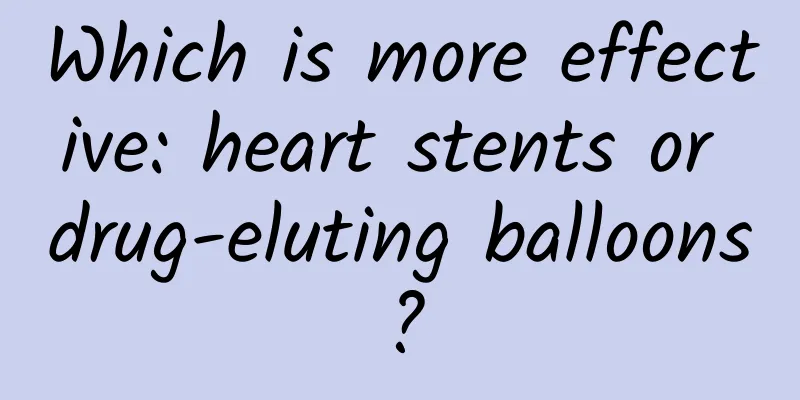Which is more effective: heart stents or drug-eluting balloons?

|
As the incidence of coronary heart disease continues to rise, the terms angiography, stents, and balloons have gradually become widely known. These treatments are all part of "percutaneous coronary intervention". Among these treatments, heart stents and drug-eluting balloons are the most common. Which one is better, heart stents or drug-eluting balloons? What do doctors base their recommendations on? To clarify this question, let us first take a look at several common percutaneous coronary intervention techniques. Coronary angiography Coronary angiography is currently considered the "gold standard" for determining the degree of cardiovascular stenosis and diagnosing coronary atherosclerotic heart disease. Doctors can obtain accurate information on coronary artery lesions through coronary angiography, thereby choosing the best treatment plan. Coronary angiography is a procedure in which a catheter is inserted into the aortic root along the direction of the arterial blood vessel through a puncture of the radial artery of the patient's upper limb or the femoral artery of the lower limb. The opening of the coronary artery is then searched for at the aortic root. The catheter is then extended to the coronary artery opening and contrast agent is injected. Generally, through the machine's shooting, the doctor can observe the development of the patient's coronary artery, thereby performing a radiological imaging examination. Coronary stenting Coronary stent implantation is what we often call "heart stents". When coronary angiography finds that the patient's blood vessel stenosis is greater than 70%, or even if the stenosis does not reach this level, but angina attacks are frequent, the doctor will consider stent treatment based on the patient's overall condition. After obtaining the informed consent of the family, the doctor will insert a slightly thicker guide catheter and guide wire along the previously established pathway. Through the new pathway, the doctor will first send a balloon to the narrowed position. After the balloon expands, it will open the narrowed blood vessel. Then the doctor will deflate the balloon and remove it, and then send the delivery system composed of "balloon + stent" to the location of the lesion. The stent is a mesh of metal that is compressed and wrapped on the surface of the balloon. When this combination reaches the predetermined position, the doctor will expand the stent and remove the balloon, and the stent will remain in the blood vessel. This allows blood to flow normally and restores blood supply. Some patients worry that the stent will shift or even fall off after being placed. There is no need to worry. Over a long period of time, the metal stent is directly exposed to the blood vessels. Under ideal conditions, the endothelial cells on the vascular lining will gradually grow and cover the stent until it is wrapped around the stent and becomes one with the blood vessel. Just like a tree takes root deeply in the soil, the stent also takes root in the blood vessels and remains for life. Heart stents are mainly suitable for patients with moderate to severe stable angina pectoris who have coronary artery stenosis of more than 70% as shown by coronary angiography, or unstable angina pectoris who are not well treated with drugs, and are also suitable for patients with acute myocardial infarction. For patients with acute myocardial infarction, time is life. Using stents to quickly open blocked blood vessels has a better effect on restoring heart function than thrombolysis and drug treatment. Of course, whether a patient is suitable for stent treatment depends on the type of coronary artery lesions. If it is a simple lesion (1-2 stenosis), it is suitable for stent implantation; if it is a serious lesion, such as left main trunk lesions, diffuse lesions, and severe calcification lesions, it is better to undergo coronary artery bypass surgery. Drug-eluting balloon dilatation Compared with ordinary balloons, the surface of drug balloons is attached with a layer of anti-proliferative drugs, which is usually paclitaxel. The drug balloon is sent to the location of coronary artery stenosis. When the balloon expands, it is close to the blood vessel wall for 30-60 seconds. At this time, the drug will penetrate into the subendothelial tissue cells of the blood vessels to prevent restenosis of the blood vessels. After the drug balloon is released, the drug is immediately withdrawn from the blood vessel, and the drug is released to the blood vessel wall. After that, the doctor will withdraw the balloon, leaving only the drug on the wall to slowly and continuously play a role, thereby preventing blood vessel stenosis. The drug action time can reach 2-4 weeks. No foreign matter remains in the body, avoiding the re-implantation of the stent, as if an "invisible stent" is implanted for the patient. Compared with stents, drug-eluting balloons are more suitable for the following situations: 1. The area where the stent was originally placed has become narrow again and the stent cannot be implanted again; 2. The diseased blood vessels are so small that the stent cannot enter; 3. The diseased blood vessels are bifurcated, making it difficult to treat with stents; 4. The patient is at risk of bleeding and cannot take dual-antibody drugs orally for a long time. Now, we have a preliminary understanding of heart stents and drug-eluting balloons. So, should we choose stents or balloons? This mainly depends on the indications, and we need to listen to the advice of professional doctors. No treatment is perfect. Whether you choose a heart stent or a drug-eluting balloon, you must do the following after the surgery: 1. Take antiplatelet drugs on time as prescribed by your doctor; 2. Regular outpatient review; 3. Low-salt, low-fat, and low-cholesterol diet; 4. Perform aerobic exercise that suits you, such as jogging, Tai Chi, walking, etc.; 5. Avoid adverse factors such as straining during bowel movements and emotional excitement. Let us develop good living habits and protect cardiovascular health! |
<<: Individualized treatment of lung cancer: a customized plan for each patient
Recommend
Causes of gout in women
The main cause of gout among female friends is re...
How does IVF improve egg quality?
If a couple cannot get pregnant normally, the mos...
How can a woman with a septate uterus get pregnant?
Many people wonder whether pregnancy is possible ...
What are the benefits of having type O blood for women?
Our blood actually has many types. As you may alr...
What flows out from below is like tofu dregs
Women's leucorrhea is consistent with their m...
Every woman must guard these five "holes"
The incidence of vaginitis is very high, and now ...
Why does my breast feel swollen and painful?
A woman's breasts are a major symbol of her f...
What soup to drink after menstruation to replenish qi and blood
In fact, after menstruation, many female friends ...
A woman with a mole on her ear
Moles are common on people's bodies. They are...
Can dysmenorrhea lead to infertility?
Dysmenorrhea is a common problem for women, and w...
Popular Science Class - What is peritoneal dialysis?
When it comes to uremia, most people know more or...
How can elderly friends stay away from influenza?
This is the 4755th article of Da Yi Xiao Hu 1. Wh...
What causes back pain after transplantation?
Some women marry and have children late or have g...
How to treat vulvovaginitis?
The structure of women's genitals is relative...









